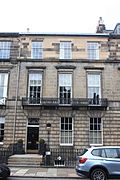Publishers
Its first publishers were Alexander Donaldson and John Reid. Reid's name appeared on the masthead briefly, only through 21 August 1764, at which time, only Donaldson's continued. [9] Donaldson, a bookseller as well as printer and publisher, is most notable for the 1774 Donaldson v Beckett court case relating to shared perpetual copyrights. In 1774, the newspaper passed from Donaldson to his son, James Donaldson. In 1820, James sold the paper to Claud Muirhead of Heriot Row and Gogar Park, Midlothian. [10] Of the large fortune made by the Donaldsons, James bequeathed it for the endowment of Donaldson's Hospital. [11]
Operations
Claud's father, James Muirhead, printer, Burgess and Guild Brother, served as the newspaper's printer, principal manager and superintendent. [8] Rev. Andrew Crichton, a Scottish biographer and historian, served as editor until 1851 when he was replaced by Robert W. Paterson. For a short period, editorial control was held by Robert Chambers. [7] At one point in time, Christopher North (the pseudonym of the Scottish writer John Wilson), was said to be associated with the Edinburgh Advertiser. [12] James Macaulay was a foreman. Journeymen printers included John Bryce, James Lamb, Robert Lamb, and George Robertson. Two of the pressmen were James Thomson and Joseph Thompson. [13]
The paper was run frugally. [14] Its initial cost was 2½d, and it was increased to 7d by 1820. [15] It covered news, religion, trade, manufacturing, agriculture, politics, and entertainment of Great Britain and the Colonial United States; it also published essays. [16] Its motto, Quidquid agunt homines, uotum, timor, ira, uoluptas, gaudia, discursus, nostri farrago libelli, [16] (translation: "whatever men do – prayer, fear, rage, pleasure, joy, running about – is the grist of my little book") is a satire by the Roman poet Juvenal.
Office locations for the Edinburgh Advertiser
This page is based on this
Wikipedia article Text is available under the
CC BY-SA 4.0 license; additional terms may apply.
Images, videos and audio are available under their respective licenses.



